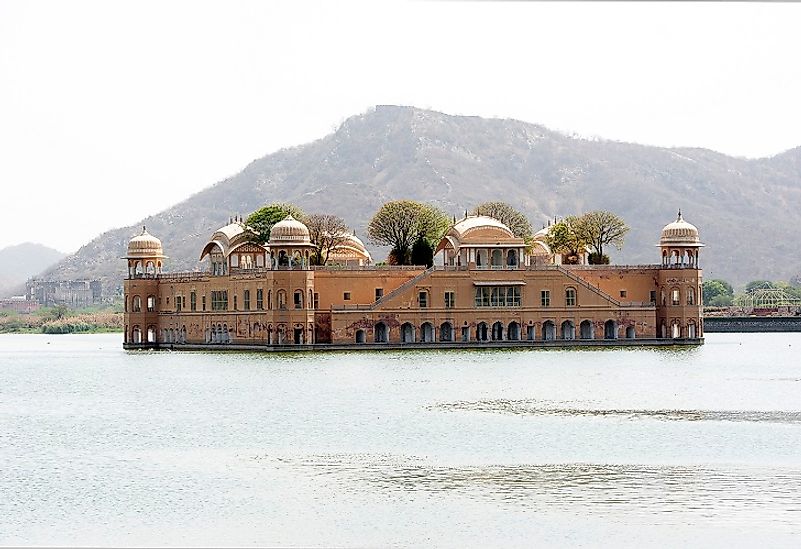The Jal Mahal - Floating Palace Of Rajasthan, India

5. Description and History
Jaipur, the capital city of India’s Rajasthan State is well known for its rich history and marvelous architectural wonders that encompass massive forts, luxurious royal palaces, havelis, museums, and more. Every corner of the city reminds one of the prosperity and wealth of India before the colonial period and defines luxury in every possible way. The Jal Mahal is one such unique architectural beauty in the city, located in the midst of a vast lake called the Man Sagar Lake. The name of the construction, Jal Mahal means the Water Palace in the local language since the palace is located in the midst of a lake with a large part of it submerged under water. Though sufficient data regarding the exact date of construction of this palace is not known, it is estimated that the palace was enlarged and renovated by the rule of Amber in Jaipur, Maharaja Jai Singh II in the 18th Century while other reports suggest that it was built in 1799 by the Amber ruler Madho Singh. The history of the Man Sagar Lake in which the palace is situated dates back to 1596 AD. During this time, there was no permanent lake but only a natural depression in its place that would fill up with water during the rains. When a famine struck the region in 1596 AD and resulted in huge suffering for the people of the region, the then ruler of Amber directed the construction of a dam in the depression to store water for use during times of need. Thus, the Man Sagar Dam, initially made of quartzite and mud and then later stabilized with stone in the 17th Century, was built. From that time on, the dam, the lake, and the palace have been renovated several times by the kings of Jaipur prior to the colonial period and by the Government of India after India’s independence and today continues to draw thousands of tourists to the spot.
4. Tourism
Tourists to Jaipur City almost always visit the Jal Mahal as part of their itinerary. However, without special permission, no one is allowed to enter this palace. One can, however, watch the palace from the land and capture stunning photographs of the palace amidst the blue lake and listen to narratives from the guide about its history, construction, and other interesting facts and details. For tourists, Jal Mahal is indeed a treat to the eyes. There are also several other tourist destinations in the city of Jaipur including the grand Amber fort, the stunning Jaipur City Palace, and the Hawa Mahal. Jaipur is easily accessible by flights from all the major metropolitan cities of India like Delhi, Mumbai and Kolkata. It is also accessible via trains and national highways connecting Jaipur to Delhi and Mumbai.
3. Architecture and Uniqueness
The Jal Mahal is a perfect blend of Rajput and Mughal architectural styles. The palace is built of red sandstone and interestingly, though the palace is five storied, only the top story is visible above the water surface when the lake is full. Every doorway, archway, and balcony of the Jal Mahal bears exquisite carvings that enthralls the visitors with their aesthetic wealth. There are four semi-octagonal towers at the four corners of the palace with cupolas (small domes) at the top. The terrace houses a landscaped garden with arched passageways and four well-decorated chhatris (pavilions) at the four sides. In its entirety, the Jal Mahal is truly a unique destination in India.
2. Nature, Sights, and Sounds
The Jal Mahal and its surroundings offer a serene and charming sight to the onlookers visiting this destination. In the past, the palace served as a picnic ground for the Indian kings and their nobles where they would organize feasts and hunt ducks for enjoyment. The Man Sagar Lake was also a famous birding spot where large numbers of migratory birds would arrive each year, offering a treat to all eyes. The lake was once home to around 150 species of local and migratory birds of all sizes, shapes and colors. Today, with the declining water quality and water level of the lake, the arrival of birds has declined. However, extensive restoration work has helped the lake recover from a dire situation and today birds like common moorhens, blue-tailed bee eaters, grey herons, and white-browed wagtails can still be sighted in the waters of the Man Sagar Lake.
1. Threats and Conservation
The major threats posed to the Man Sagar Lake and its Jal Mahal derives from extensive silting of the lake due to erosion of its surrounding habitat as well as pollution of the lake by sewage water entering the lake from the rapidly growing urban settlements in the area. The Jal Mahal has also suffered several episodes of water logging in the past and developed cracks and fractures in its structure. Noticing these threats, the state Government of Rajasthan launched a massive restoration project in 2001 involving afforestation programs, reversing the silting of the lake, realignment of drainage systems around the lake, repair and restoration of the cracks and crevices in the Jal Mahal, and the establishment of migratory bird nesting islands on the lake. Finally, after years of hard work, the successful implementation of the project helped in returning the Jal Mahal and its surrounding habitat to their past glory, attracting tourists from across the world today to this tourist destination in India.











